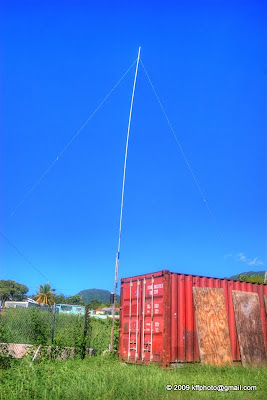The next step up
The great outdoors where an amateur radio operator in our Federation of Saint Kitts and Nevis can experiment with any antenna design so long as it does not cause any interference with anyone else. However, there is no protection for the amateur radio operator from RF interference generated by certain business operations in Saint Kitts, even though the law of the land declares that the interference is illegal, and the authority charged with upholding the law has requested the entity to cease generation of the interference. This interference has been going on since about 2017. It is all about talk, talk and more talk, and nothing is being done. Occasionally there seems to be some sort of activity which could give an impression that something good is happening, but then the noise seem to get worse. Personally, I have stopped stressing over this interference situation, but I am leaving this matter in the hands of the Master who I believe will fix this in due time.
In between time it is left to us, amateur radio operators, to do the best that we can with what we have left. I am pleased to hear that 2, 3 or 4 amateur radio operators have invested in HF radios. I wish to congratulate all of them for making that life changing decision. For reader information that is a four figured investment. Just to give you an idea so that you can appreciate the seriousness of these ham radio operators, a popular radio these days is the Yaesu FT-991A. On the Yaesu website it can found here.
Another great Yaesu radio, just released in 2020 is the FTdx 10 which brags the SDR technology. It is ranked at #3 on the Sherwood Engineering website where radio performance is tested. All the "hot" radio of the day are tested, and their performance specifications logged here. You can see how your popular radio fared against their competitors. Note that all radios are not tested. Only the "supposedly hot" ones. See the website Receiver Test Data Table here.
http://www.sherweng.com/table.html
See the Yaesu FTdx 10 here.
Take a minute and search YouTube for radio user information, and more about amateur radio products that interest you. A few weeks ago I was browsing YouTube and came across the EFHW, end fed half wave antenna. It sounded interesting and I investigated. Long story short, I have now built and tested my own 49 to 1 air core balun and hope to test it out shortly. This is a simple antenna, and seems like the solution to the typical DX problem that many of the local amateur radio operators run into. Most operators seem to feel that the dipole is the best antenna for the job. It is good if it can be kept horizontal, as in 'arrow' straight, but in any other configuration like sloping dipole or whatever, the performance goes down drastically. The dipole is hard to beat when straight, and up above 20 feet. The lower the frequency the higher the dipole should be.
I prefer the EFHW, end fed half wave antenna in a vertical position because it guarantee low angle radiation in all directions, from 5 degrees to about 35 degrees. Later I will experiment with a 5/8 wavelength end fed antenna, where the take off angle is 3 degrees to 27 degrees. The take off angle for the regular quarter wave vertical is 10 degrees to 55 degrees. These antennas would be great to experiment with on 40 and 80 meters, those are the amateur radio frequencies that and jammed and blocked 24x7 by the illegal RF interference caused by the local electric company. But that will not stop my experiments, and we will see what we can hear, until the interference goes away.
To get the maximum performance from any antenna, the antenna must be properly tuned and adjusted, this require a good quality antenna analyzer. A good analyzer is one that is known to be accurate in all measurements. I can only speak for my own analyzer a Rig Experts model. If a ham radio operator plans to get involved with his or her antennas on a regular basis, I would suggest that they invest in a good antenna analyzer like a Rig Experts. I am of the view that some folks buy an antenna analyzer for frequencies that they do not use. I will install a VHF and a UHF antenna, but all my antenna work for now is at HF, so I invested in an HF antenna analyzer. The price of the VHF and UHF analyzers are out of my reach. The antenna analyzer website can be found here. https://rigexpert.com/products/antenna-analyzers/
[to be continued]




Comments